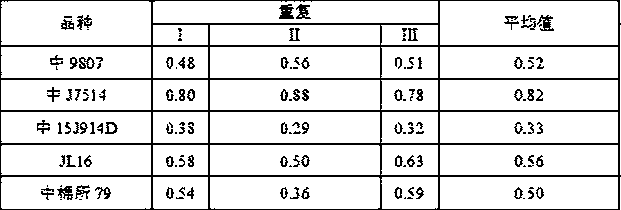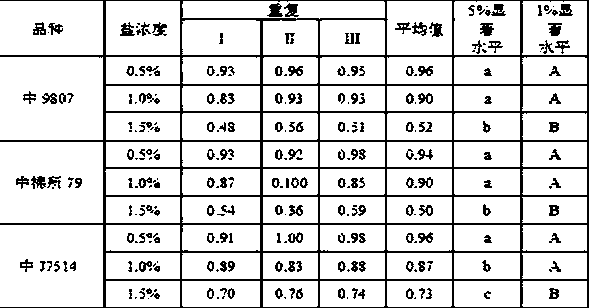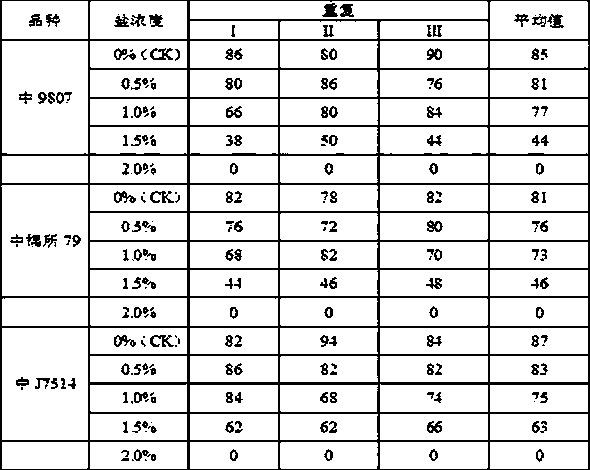Method for authenticating salt tolerance of cotton seeds
A technology for cotton seeds and salt tolerance, applied in the field of seed screening and evaluation, can solve the problems of difficult control of the identification technology environment, long identification period, large human error, etc., and achieve the effects of short identification period, easy promotion and implementation, and easy operation.
- Summary
- Abstract
- Description
- Claims
- Application Information
AI Technical Summary
Problems solved by technology
Method used
Image
Examples
Embodiment 1
[0039] Step 1. Sample preparation:
[0040] From the fully mixed net seeds, 2000 9807 cotton seeds were randomly selected.
[0041] Step 2, Stress cultivation: Set up four concentration gradients of 0.5%, 1.0%, 1.5% and 2.0%, and repeat each concentration 4 times, with 100 grains per repetition. Add 15 ml of 0.5%, 1.0% and 1.5% sodium chloride solution to every 100 g of dry sand, the pH is 6.0-7.5, stir evenly, spread 1.5 cm thick wet sand in the germination box, and put 4 repeated seeds to be tested , placed evenly on the flattened sand bed, flattened the seeds with a flat-bottomed container, making half of them sink into the sand, and covered with a layer of wet sand with a thickness of 1.0 cm, spread evenly, covered, and placed at 30 ℃ In the light incubator at ±1 °C, after the cotyledon was exposed to the sand surface, it was lighted for 8 hours during the day, and the light intensity was ≥1200 lx.
[0042] Step 3, control cultivation: 4 repetitions, 100 grains per repet...
Embodiment 2
[0045] Step 1. Sample preparation:
[0046] From the fully mixed net seeds, 2000 grains of 79 cotton seeds of China Cotton Institute.
[0047] Step 2, Stress cultivation: Set up four concentration gradients of 0.5%, 1.0%, 1.5% and 2.0%, and repeat each concentration 4 times, with 100 grains per repetition. Add 15 ml of 0.5%, 1.0% and 1.5% sodium chloride solution to every 100 g of dry sand, the pH is 6.0-7.5, stir evenly, spread 1.5 cm thick wet sand in the germination box, and put 4 repeated seeds to be tested , placed evenly on the flattened sand bed, flattened the seeds with a flat-bottomed container, making half of them sink into the sand, and covered with a layer of wet sand with a thickness of 1.0 cm, spread evenly, covered, and placed at 30 ℃ In a light incubator at ±1 °C, light for 8 h during the day was started after the cotyledons were exposed to the sand surface.
[0048] Step 3, control cultivation: 4 repetitions, 100 grains per repetition. Add 15 ml of deionize...
Embodiment 3
[0051] Step 1. Sample preparation:
[0052] From the fully mixed net seeds, randomly select 2000 J7514 cotton seeds.
[0053] Step 2, Stress cultivation: Set up four concentration gradients of 0.5%, 1.0%, 1.5% and 2.0%, and repeat each concentration 4 times, with 100 grains per repetition. Add 15 ml of 0.5%, 1.0% and 1.5% sodium chloride solution to every 100 g of dry sand, the pH is 6.0-7.5, stir evenly, spread 1.5 cm thick wet sand in the germination box, and put 4 repeated seeds to be tested , placed evenly on the flattened sand bed, flattened the seeds with a flat-bottomed container, making half of them sink into the sand, and covered with a layer of wet sand with a thickness of 1.0 cm, spread evenly, covered, and placed at 30 ℃ In a light incubator at ±1 °C, light for 8 h during the day was started after the cotyledons were exposed to the sand surface.
[0054] Step 3, control cultivation: 4 repetitions, 100 grains per repetition. Add 15 ml of deionized water to every 10...
PUM
 Login to View More
Login to View More Abstract
Description
Claims
Application Information
 Login to View More
Login to View More - R&D
- Intellectual Property
- Life Sciences
- Materials
- Tech Scout
- Unparalleled Data Quality
- Higher Quality Content
- 60% Fewer Hallucinations
Browse by: Latest US Patents, China's latest patents, Technical Efficacy Thesaurus, Application Domain, Technology Topic, Popular Technical Reports.
© 2025 PatSnap. All rights reserved.Legal|Privacy policy|Modern Slavery Act Transparency Statement|Sitemap|About US| Contact US: help@patsnap.com



